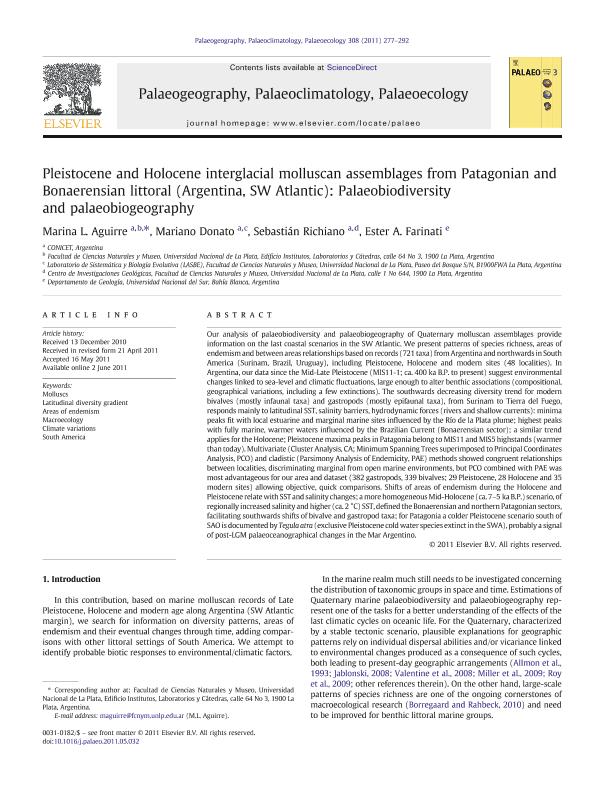Mostrar el registro sencillo del ítem
dc.contributor.author
Aguirre, Marina Laura

dc.contributor.author
Donato, Mariano Humberto

dc.contributor.author
Richiano, Sebastián Miguel

dc.contributor.author
Farinati, Ester Amanda

dc.date.available
2019-09-09T18:38:24Z
dc.date.issued
2011-08
dc.identifier.citation
Aguirre, Marina Laura; Donato, Mariano Humberto; Richiano, Sebastián Miguel; Farinati, Ester Amanda; Pleistocene and Holocene interglacial molluscan assemblages from Patagonian and Bonaerensian littoral (Argentina, SW Atlantic): Palaeobiodiversity and palaeobiogeography; Elsevier Science; Palaeogeography, Palaeoclimatology, Palaeoecology; 308; 3-4; 8-2011; 277-292
dc.identifier.issn
0031-0182
dc.identifier.uri
http://hdl.handle.net/11336/83150
dc.description.abstract
Our analysis of palaeobiodiversity and palaeobiogeography of Quaternary molluscan assemblages provide information on the last coastal scenarios in the SW Atlantic. We present patterns of species richness, areas of endemism and between areas relationships based on records (721 taxa) from Argentina and northwards in South America (Surinam, Brazil, Uruguay), including Pleistocene, Holocene and modern sites (48 localities). In Argentina, our data since the Mid-Late Pleistocene (MIS11-1; ca. 400. ka B.P. to present) suggest environmental changes linked to sea-level and climatic fluctuations, large enough to alter benthic associations (compositional, geographical variations, including a few extinctions). The southwards decreasing diversity trend for modern bivalves (mostly infaunal taxa) and gastropods (mostly epifaunal taxa), from Surinam to Tierra del Fuego, responds mainly to latitudinal SST, salinity barriers, hydrodynamic forces (rivers and shallow currents): minima peaks fit with local estuarine and marginal marine sites influenced by the Río de la Plata plume; highest peaks with fully marine, warmer waters influenced by the Brazilian Current (Bonaerensian sector); a similar trend applies for the Holocene; Pleistocene maxima peaks in Patagonia belong to MIS11 and MIS5 highstands (warmer than today). Multivariate (Cluster Analysis, CA; Minimum Spanning Trees superimposed to Principal Coordinates Analysis, PCO) and cladistic (Parsimony Analysis of Endemicity, PAE) methods showed congruent relationships between localities, discriminating marginal from open marine environments, but PCO combined with PAE was most advantageous for our area and dataset (382 gastropods, 339 bivalves; 29 Pleistocene, 28 Holocene and 35 modern sites) allowing objective, quick comparisons. Shifts of areas of endemism during the Holocene and Pleistocene relate with SST and salinity changes; a more homogeneous Mid-Holocene (ca. 7-5. ka B.P.) scenario, of regionally increased salinity and higher (ca. 2°C) SST, defined the Bonaerensian and northern Patagonian sectors, facilitating southwards shifts of bivalve and gastropod taxa; for Patagonia a colder Pleistocene scenario south of SAO is documented by Tegula atra (exclusive Pleistocene cold water species extinct in the SWA), probably a signal of post-LGM palaeoceanographical changes in the Mar Argentino. © 2011 Elsevier B.V.
dc.format
application/pdf
dc.language.iso
eng
dc.publisher
Elsevier Science

dc.rights
info:eu-repo/semantics/openAccess
dc.rights.uri
https://creativecommons.org/licenses/by-nc-sa/2.5/ar/
dc.subject
Areas of Endemism
dc.subject
Climate Variations
dc.subject
Latitudinal Diversity Gradient
dc.subject
Macroecology
dc.subject
Molluscs
dc.subject
South America
dc.subject.classification
Paleontología

dc.subject.classification
Ciencias de la Tierra y relacionadas con el Medio Ambiente

dc.subject.classification
CIENCIAS NATURALES Y EXACTAS

dc.subject.classification
Paleontología

dc.subject.classification
Ciencias de la Tierra y relacionadas con el Medio Ambiente

dc.subject.classification
CIENCIAS NATURALES Y EXACTAS

dc.title
Pleistocene and Holocene interglacial molluscan assemblages from Patagonian and Bonaerensian littoral (Argentina, SW Atlantic): Palaeobiodiversity and palaeobiogeography
dc.type
info:eu-repo/semantics/article
dc.type
info:ar-repo/semantics/artículo
dc.type
info:eu-repo/semantics/publishedVersion
dc.date.updated
2019-09-04T19:29:19Z
dc.journal.volume
308
dc.journal.number
3-4
dc.journal.pagination
277-292
dc.journal.pais
Países Bajos

dc.journal.ciudad
Amsterdam
dc.description.fil
Fil: Aguirre, Marina Laura. Consejo Nacional de Investigaciones Científicas y Técnicas. Centro Científico Tecnológico Conicet - La Plata; Argentina. Universidad Nacional de La Plata. Facultad de Ciencias Naturales y Museo; Argentina
dc.description.fil
Fil: Donato, Mariano Humberto. Consejo Nacional de Investigaciones Científicas y Técnicas. Centro Científico Tecnológico Conicet - La Plata; Argentina. Universidad Nacional de La Plata. Facultad de Ciencias Naturales y Museo; Argentina
dc.description.fil
Fil: Richiano, Sebastián Miguel. Consejo Nacional de Investigaciones Científicas y Técnicas. Centro Científico Tecnológico Conicet - La Plata. Centro de Investigaciones Geológicas. Universidad Nacional de La Plata. Facultad de Ciencias Naturales y Museo. Centro de Investigaciones Geológicas; Argentina
dc.description.fil
Fil: Farinati, Ester Amanda. Universidad Nacional del Sur. Departamento de Geología; Argentina
dc.journal.title
Palaeogeography, Palaeoclimatology, Palaeoecology

dc.relation.alternativeid
info:eu-repo/semantics/altIdentifier/doi/https://doi.org/10.1016/j.palaeo.2011.05.032
dc.relation.alternativeid
info:eu-repo/semantics/altIdentifier/url/https://www.sciencedirect.com/science/article/pii/S003101821100277X
Archivos asociados
